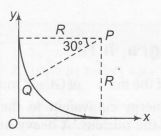A small block of mass 1 kg is released from rest at the top of a rough track. The track is a circular arc of a radius of 40 m. The block slides along the track without toppling and a frictional force acts on it in the direction opposite to the instantaneous velocity . The work done in overcoming the friction up to the point Q , as shown in the figure, is 150 J .(take the acceleration due to gravity , g=10 ms-2)

The magnitude of the normal reaction that acts on the block at the point Q is